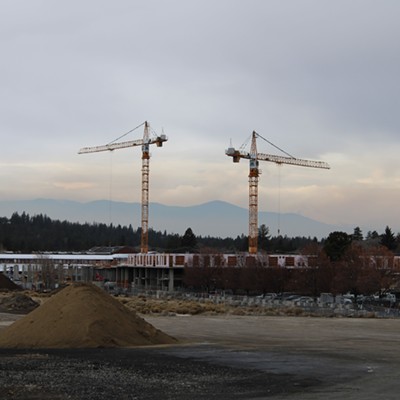It was early June when Mari V. went to do a load of laundry one morning and found the machine had no water. Then, she turned on the faucet — again, no water.
Mari, who owns and lives at a horse farm near Tumalo, typically relies on a 545-feet-deep well to give her horses water and meet household needs. That is, until last month.
When a pump company came to investigate, "There was only about 5 inches of mucky water at the bottom," recalled Mari, who asked to omit her last name and business name in case she someday wants to sell the property.
Mari was left to join the growing number of rural Central Oregonians scrambling to deepen their wells or find a new water source altogether, with many drilling companies months out from relief and drilling costing tens of thousands of dollars. This comes as—despite the wet spring—the region enters its second summer of extreme drought, and farmers and rural residents are experiencing water shortages in ways people living within city limits don't see.
The region has experienced some level of drought conditions for the last 20 years, and although precipitation levels have been high compared to previous years, that's barely making a dent. According to Chrissy Lucas, a groundwater protection specialist at Oregon State University, "You can't make up for all of that drought and the lack of rain in one or two years."
Well owners in Central Oregon aren't alone: Across the world, millions of wells are expected to run dry, as groundwater is depleted from overpumping and drier climates.
Groundwater in decline
Groundwater is a critical resource in Central Oregon. While most farmers in the region rely on surface water for irrigation, residents and businesses outside municipal areas largely depend on private wells to meet their water needs.
This groundwater is part of an aquifer, which flows like an underground river deep below Earth's surface. Every year, the snowfall from the Cascade Mountains replenishes the aquifer, as spring snowmelt seeps into the porous volcanic rock.
But, according to the latest study from the U.S. Geological Survey, between 1997 and 2008, groundwater levels in the central part of the Upper Deschutes Basin—from Sisters to Powell Butte— declined as much as 14 feet. Climate conditions and the region's ongoing drought account for much of this decline: A smaller snowpack means less water flows into the aquifer.
Climate, however, can't explain all the water declines throughout the basin. Experts point to the piping of irrigation canals as another reason for groundwater decline. For a long time, up to 50% of water from canals seeped into the ground before it reached farms, potentially keeping the aquifers artificially high, according to the Oregon Water Resource Department's watermaster for the region, Jeremy Giffin, who's charged with regulating and distributing water from the state.
"Water's a precious resource and we're going to have to really learn to conserve it and use what we have." —Jeremy Giffin
tweet this
In order to make irrigation systems more efficient, piping or lining canals is now a priority throughout Central Oregon. And while this may be good for farmers, groundwater is feeling the effects.
"Maybe we filled up the aquifer with a pillow of water from all the canal leaking," Giffin said. "And now that we're starting to pipe canals and conserve water, that's subsiding down to a more natural level."
On top of this, experts also speculate that, as the population grows, over-pumping is lowering the water table. The population in Deschutes County has expanded rapidly, and with that comes a reliance on groundwater to satisfy the increased demand for water.
"So especially in areas like Central Oregon, we're pumping it out faster than it's being able to naturally recharge itself with the rainfall," Lucas, with OSU, said. "The land itself doesn't have the carrying capacity for the number of people that are living there and using the resources."
This is a big reason critics are pushing back against developments like Thornburgh, a proposed resort near Cline Butte that was permitted in 2013 to use up to 6 million gallons of groundwater a day. This is more than 50 times what the average Bend water customer used in the entire year of 2021, according to public records.
Thornburgh's water permit is currently in legal limbo, as regulators consider if the plan still makes sense in the current climate. The Department of State Lands is currently considering whether to approve the sale of a piece of additional land for the resort, and doesn't expect a decision till early August at the earliest. The public comment period has been extended until July 29, and hundreds of residents have already spoken out against the sale. Many worry the resort will take away from their already declining water supply and undersupply a nearby creek. As someone who's experienced groundwater shortages firsthand, Mari said it's "very frustrating" hearing about new resorts like this.
"Water's a precious resource and we're going to have to really learn to conserve it and use what we have." Jeremy Giffin
tweet this
Currently, anyone who wants a well must apply for a permit, but there are no state regulations on where they can be dug. Wells are approved even in areas where the groundwater is over-appropriated or the impact to the aquifer is unknown. The Oregon Water Resources Commission is currently considering an approach that would deny permits for new wells in places where groundwater is over-appropriated and where data is lacking, but the commission wouldn't vote to adopt the new rules until 2023 at the earliest.
Meanwhile, residents will continue to suffer from potentially overused aquifers. Giffin said, as of May 18, he'd received 33 complaints of wells drying up this year in the Upper Deschutes Basin, though the true number is likely many times higher. The number of complaints took off in the last two years, he said, with areas like Redmond particularly hard-hit and the wave of groundwater dissipating the further east you go.
"We've been blessed with ample supply of water for a long time in this basin for being a high desert," Giffin said, but that's changing. "[Water's] a precious resource and we're going to have to really learn to conserve it and use what we have."
Digging the way out
Carol Hocker, a Redmond School District employee, has lived with her family on a 2.25-acre lot in northwest Redmond since 1995. Until February, a 250-foot well had been a steady source of water for her family and two neighboring families.
That was until they noticed air bubbles in the water. Sure enough, the well was going dry. Much like trying to drink the last sip of a milkshake with a straw, the pump was having a hard time slurping up the last bits of water.
Since the well wasn't originally registered with the state, the families had to dig an entirely new one, and it wasn't until late June that Abbas Well Drilling & Pump Service could drill a new well — a nearly six-month wait.
In the last couple years, popular local drilling companies, such as Abbas and Aiken Well Drilling have seen an uptick in inquiries across Central Oregon. One employee at Aiken said the company is receiving 10 to 20 calls a week about wells drying up — the highest number they've seen.
So, for many families like Hocker's, it's been a waiting game, and meanwhile, every day has felt like camping, Hocker said. Her family has been washing their clothes elsewhere and taking short showers. None of the families using the well have watered their lawns or planted gardens for fear of running out of water.
"Every day we turn the water on and it's spitting and spurting, we're like, 'OK, is this the day it's going to stop?' she said in mid-June. "We're always worried it's going to stop today — because it could."
Luckily for those families, when the drilling company came in late June, they found water quickly, just 350 feet down — which is relatively shallow in a region where some wells are 800 feet deep. Drilling companies typically charge by the foot, and a new well — with pumps — can add up to an average of $50,000, according to Andy High, the owner of Thompson Pump & Irrigation. This is a steep price for families, especially those already living on the edge.
"If you're rural and you're [living on a] fixed income or you're just trying to make it, you don't have $50,000 sitting around to throw at a new well," High said.
For small businesses, digging a new well is especially financially taxing. Mari, who owns the Tumalo horse farm, has been paying for water to be delivered to her property every four days. She has a cistern to store this water and keep meeting basic needs, but these deliveries add up to nearly $1,500 a month.
"We're a small business," she said. "It's a big expense."
But that'll soon come to an end. The state finally approved Mari to dig deeper, and a drilling company was able to start on June 29. Still, the drillers don't know how deep they'll have to go, and that's stressful for Mari.
"I think we'll survive it," she said. "But I do worry what the long-term look for Bend will be if growth continues. There's only so much water."
—This story is the first part of a series exploring water shortages in Central Oregon. The next installment will explore how some farmers in the high desert are feeling the effects of the drought more than others.
What to do if your well runs dry
Get a backup water storage tank, such as a cistern. According to Chrissy Lucas, with OSU, even well owners who aren't experiencing water shortages should have a back-up tank in case of emergencies. See https://wellwater.oregonstate.edu/ for more information for well owners.
Contact a licensed well constructor or pump installer to access the well, if you are experiencing trouble with your water supply. Oftentimes, wells get clogged due to a lack of maintenance and haven't actually gone dry. If you do need to dig deeper or construct a new well, find a licensed well constructor: https://go.usa.gov/xGMCX
Locate your well log. This provides details on geologic formations encountered in a well, as well as details about the well design, construction and yield, and can help you decide what to do if your well has gone dry. If there is a copy of your well log, you can find it through the water resource department: https://apps.wrd.state.or.us/apps/gw/well_log/
Report a dry well or significant reductions in water volume to the Oregon Water Resources Department: https://go.usa.gov/xFbW3. This helps scientists monitor groundwater supply, and the department may notify you of relevant funding and assistance.
Apply for funding. In addition to Oregon-specific grants, funding may be available from the U.S. Department of Agriculture, which provides loans to low-income homeowners up to $40,000 to repair or improve homes, including private water wells. See: https://www.rd.usda.gov/programs-services/single-family-housing-programs/single-family-housing-repair-loans-grants/or
Read Oregon Water Resources Department's well owners handbook for more information:



























